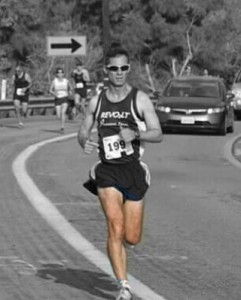Running is all about your legs.

When you run, many enzymes are busy at work in your calves, hamstrings, quadriceps, and other muscles, catalyzing numerous chemical reactions to break down carbohydrates and fat for fuel, including the one that breaks the strong bonds of ATP molecules we learned about in high school biology class to liberate energy for muscle contraction. Many of those enzymes live inside the mitochondria—the cells’ oxygen-using factories—which are responsible for everything inside of us that is aerobic—and that’s pretty much everything.
Running is a potent stimulus to proliferate mitochondria. Having more mitochondria in our muscles—along with the enzymes inside of them—increases our muscles’ ability to produce energy aerobically, shifting metabolism toward a greater reliance on fat when running at a specific pace. By increasing our muscles’ aerobic capacity, we delay their reliance on anaerobic metabolism—chemical reactions that don’t use oxygen to produce energy—and thus can run at a faster pace before we begin to fatigue.
The link between an increase in enzyme activity and an increase in mitochondria’s capacity to consume oxygen, first made in 1967 in the muscles of rats, has provided much insight into the adaptability of skeletal muscle. Generally, the greater the demand, the greater the adaptations—run more miles, make more mitochondria.
While packing our muscles with more mitochondria enables us to hold a faster pace, it also has implications for a broader range of health issues. It is of great interest to scientists, especially because mitochondria are unique in that they have their own specific DNA.
It’s very interesting how we inherit our mitochondria. Watch the video to find out.
The mitochondria you stimulate your body to make during your runs has particular relevance for our understanding of mitochondrial diseases, the muscle damage induced by free radicals, and the age-related loss of muscle mass known as sarcopenia. If you want healthy functioning muscles as you age, you need lots of healthy mitochondria. One more reason to run.
